Analysing Reflection of Waves
- Figure shows the reflection of sea waves by a retaining wall built near the beach.
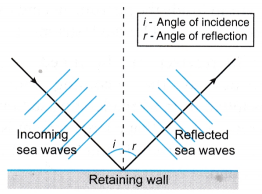
- Reflection of waves is a phenomenon that occurs when all or a part of the waves return after they encounter an obstacle. The obstacle is known as a reflector.
- A ripple tank kit is a very useful apparatus for studying waves in the laboratory. Figure shows a ripple tank in use.
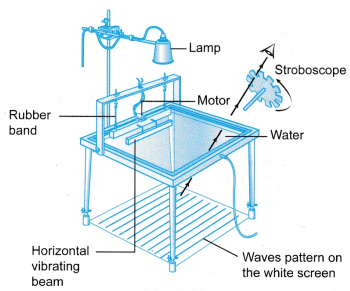 (a) When a steady train of waves move across the water surface, each wave crest acts like a convex lens and concentrates the light on the screen as shown in Figure. Flence, a bright pattern on the screen corresponds to a crest of the waves.
(a) When a steady train of waves move across the water surface, each wave crest acts like a convex lens and concentrates the light on the screen as shown in Figure. Flence, a bright pattern on the screen corresponds to a crest of the waves.
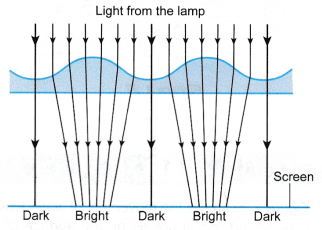 (b) A stroboscope is normally used to observe wave patterns on the screen. By rotating the stroboscope at the same frequency as the motor of the ripple tank kit, the motion of the waves can be frozen for more detailed observation.
(b) A stroboscope is normally used to observe wave patterns on the screen. By rotating the stroboscope at the same frequency as the motor of the ripple tank kit, the motion of the waves can be frozen for more detailed observation.
People also ask
- Analysing Refraction of Waves
- Analysing Interference of Waves
- Analysing Diffraction of Waves
- Analysing Sound Waves
- Analysing Electromagnetic Waves
Characteristics of Reflected Waves
Figure shows incident waves being reflected by a reflector. The angle of incidence, i is the same as that of the angle of reflection, r.
- Direction: The direction of the propagation of the waves changed after reflection.
- Angle of reflection: The angle of reflection, r is equal to reflection the angle of incidence, i.
- Wavelength: The wavelength of the reflected waves is the same as that of the incident waves.
- Frequency: The frequency of the reflected waves is the same as that of the incident waves.
- Speed: The speed of the reflected waves is the same as that of the incident waves.

Reflection of Plane Waves Experiment
Aim: To study the characteristics of reflection of plane waves in a ripple tank, light and sound waves.
Material: White paper as screen
Apparatus: Ripple tank and its accessories, stroboscope, protractor
Method:
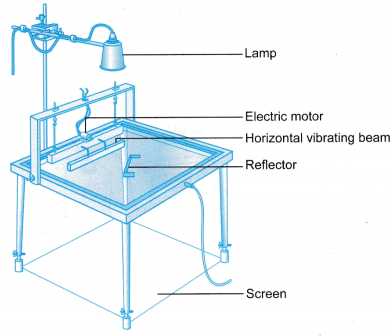
- The ripple tank is arranged as shown in Figure.
- The legs of the ripple tank are adjusted so that the base of the tank is horizontal.
- A horizontal beam vibrator is lowered until it touches the surface of the water to create plane (straight) waves.
- The speed of the motor is adjusted to produce a train of waves that can be clearly observed on the screen with the help of a stroboscope.
- A straight reflecting barrier (reflector) is placed on the tank so that the angle of incidence of the waves, i = 30°.

- The angle of the reflected waves, r is measured and recorded.
- The wavelengths of the incident and reflected waves are observed and compared.
- Steps 5 to 7 are repeated for i = 45° and 60°.
Results:

Observation:
The wavelength of the reflected waves is the same as the incident waves.
Discussion:
- From the results, the angle of reflection of the waves is equal to the angle of incidence of the waves.
- The wavelength of the waves does not change after reflection.
- The frequency of the incident and reflected waves are the same as that of the source of the waves.
- From 2 and 3, and by using the formula v = fλ, the speed of the reflected waves is the same as that of the incident waves.
Reflection of Light Experiment
Aim: To study the characteristics of reflection of light.
Materials: A piece of white paper, plasticine, pencil Apparatus: Plane mirror, ray box, power supply, protractor
Method:
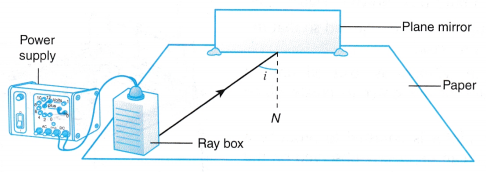
- The apparatus is set up as shown in Figure.
- The activity is carried out to determine the angle of reflection, r corresponding to the angle of incidence, i = 30°, 45° and 60°.
Results: Discussion:
Discussion:
From the results, the angle of reflection of the light, r is equal to the angle of incidence of the light, i.
Reflection of Sound Waves Experiment
Aim: To study the characteristics of reflection of sound waves.
Materials: Round cardboard tubes, a piece of soft board, a piece of plywood, a piece of white paper
Apparatus: Protractor, mechanical stopwatch as source of sound
Method:
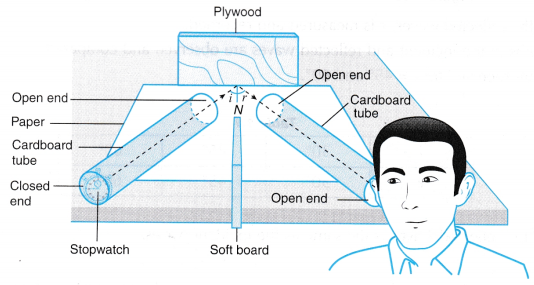
- The apparatus is set up as shown in Figure.
- A stopwatch is placed in a cardboard tube with one end open and the other end closed.
- The tube is arranged at an incident angle, i = 30°.
- Another cardboard tube with both ends open is adjusted so that one ear is placed close to one end of the tube as to hear the loudest possible ticking sound of the stopwatch.
- The angle of reflection, r of the sound wave is measured and recorded.
- Steps 3 to 5 are repeated for i = 45° and 60°.
Results:
 Discussion:
Discussion:
From the results, the angle of reflection, r is equal to the angle of incidence, i of the sound waves.
Conclusions:
- The direction of propagation of the reflected waves is different from that of the incident waves.
- The angle of reflection, r is equal to the angle of incidence, i of the waves.